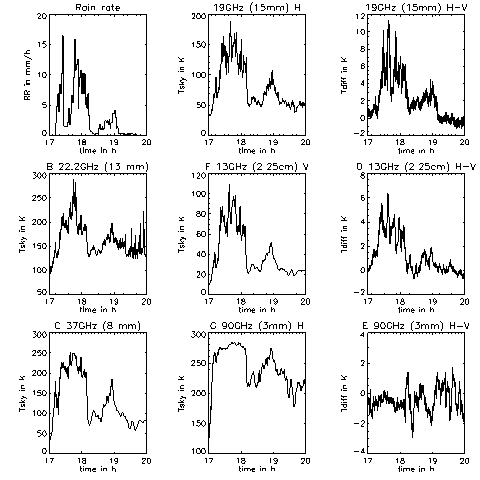IRE has a joint project with the Institute for Radiofrequency Technology (Institut fuer Hochfrequenztechnik) NE-HF of the German Aerospace Research Establishment (Deutsche Forschungsanstalt fuer Luft- und Raumfahrt) DLR entitled: "Determination of Microwave Brightness Temperature of Rain Cells by Satellite (Priroda) and Ground Measurements". The main objective is the development and validation of passive remote sensing techniques for rain rate estimation from space.
For the experimental investigation IRE has installed several radiometers in Oberpfaffenhofen, Germany, having the same frequencies as the Priroda- IKAR radiometers (13, 22.2, 37 and 90 GHz), close to a 19 GHz dual polarisation radiometer and meteorological equipment of DLR (2 raingauges, a distrometer for measurements of the size of rain drops, and sensors for humidity, temperature and pressure). Table 1 shows the specifications of the microwave radiometers.
Figure 1 represents an example of ground based multifrequency and dual polarisation measurements of rain brightness temperatures. For comparison, the rain rate measured by a rain gauge is included. Such measurements have been carried out for several months and will be continued.
With respect to the rain rate estimation from space, these measurements will be used as ground truth and validation for measurements of the Priroda-IKAR radiometers during passes of the Mir-statiom over the Oberpfaffenhofen test site (48 deg. N, 17 deg. E) within the frame of the Priroda Rain Experiment.
| Frequency [GHz]: | 90 | 37 | 22 | 19.2 | 13.5 |
| Polarisaton: | v/h | v | v | v/h | v/h |
| Sensitivty [K/s]: | 0.27 | 0.2 | 0.2 | 0.5 | 0.2 |
| Absolute accuracy [K]: | 2 | 2 | 2 | 2 | 2 |
| 3-dB beamwidth [deg]: | 3.4 | (10) | (10) | 1.2 | 15 |
| Integration time [ms]: | 1000 | 1000 | 1000 | 1000 | 1000 |
| Bandwidth [MHz]: | 2000 | 800 | 800 | 100 | 800 |
| Noise figure [dB]: | 6 | 5 | 5 | 5 | 5 |
| Antenna gain [dB]: | 30 | 30 | 45 | ||
| Sidlobes [dB]: | -20 | -15 | -15 | -32 | -40 |
| Crosspolarization [dB]: | -22 | - | - | -32 | -20 |
| Elevation [deg]: | 30 | 30 | 30 | 30 | 30 |
Table 1: Specifications of ground based radiometers in Oberpfaffenhofen.
Figure 1: Rain rate and downwelling brightness temperatures at 13, 19, 22.2, 37 and 90 GHz vs. time. The measurements were carried out with ground based radiometers in Oberpfaffenhofen, Germany under an elevation angle of 30 degree. The third column shows the temperature difference between horizontal and vertical polarisation at 19, 13 and 90 GHz.

Contact addresses
IRE RAS:
Prof. Kutuza B.G., e-mail: kutuza@mail.cplire.ru
NE-HF DLR:
Dr. Achim Hornbostel, e-mail: achim.hornbostel@dlr.de